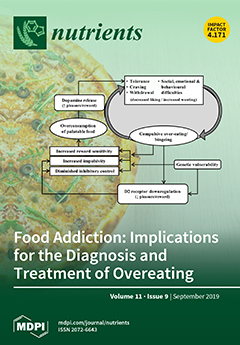Collecting dietary intake data is associated with challenges due to the subjective nature of self–administered instruments. Biomarkers may objectively estimate the consumption of specific dietary items or help assess compliance in dietary intervention studies. Our aim was to use a panel of plasma and urine biomarkers to assess the validity of self-reported dietary intake using a modified Mediterranean Diet Scale (mMDS) among firefighters participating in Feeding America’s Bravest (FAB), an MD cluster-randomized controlled trial. In our nested biomarker pilot study, participants were randomly selected from both the MD intervention group (
n = 24) and the control group (
n = 24) after 12-months of dietary intervention. At baseline data collection for the pilot study (t = 12-months of FAB), participants in the control group crossed-over to receive the MD intervention (active intervention) for 6-months. Participants in the intervention group continued in a self-sustained continuation phase (SSP) of the intervention. Food frequency questionnaires (FFQ), 13-item-mMDS questionnaires, 40 plasma fatty acids, inflammatory biomarkers and urinary hydroxytyrosol and tyrosol were analyzed at both time points. Spearman’s correlation,
t-tests and linear regression coefficients were calculated using SAS software. Overall, the mMDS derived from the FFQ was highly correlated with the specific 13-domain-mMDS (r = 0.74). The concordance between the two questionnaires for low and high adherence to MD was high for all the participants in the parent trial (κ = 0.76). After 6 months of intervention in the pilot study, plasma saturated fatty acid decreased in both groups (active intervention: −1.3 ± 1.7;
p = 0.002; SSP: −1.12 ± 1.90;
p = 0.014) and oleic acid improved in the SSP (
p = 0.013). Intake of olive oil was positively associated with plasma omega-3 (
p = 0.004) and negatively with TNF-α (
p < 0.001) at baseline. Choosing olive oil as a type of fat was also associated with higher levels of plasma omega-3 (
p = 0.019) at baseline and lower TNF-α (
p = 0.023) at follow up. Intake of red and processed meats were associated with lower serum omega-3 (
p = 0.04) and fish consumption was associated with lower IL-6 at baseline (
p = 0.022). The overall mMDS was associated with an increase in plasma omega-3 (
p = 0.021). Good correlation was found between nutrient intake from the FFQ and the corresponding plasma biomarkers (omega-3, EPA and DHA). In this MD randomized controlled trial, some key plasma biomarkers were significantly associated with key MD diet components and the overall mMDS supporting the validity of the mMDS questionnaire as well as compliance with the intervention.
Full article






